Blended Cement Market Research: 2031
The Global Blended Cement Market Size was valued at $301.2 billion in 2021, and is projected to reach $462.1 billion by 2031, growing at a CAGR of 4.2% from 2022 to 2031. Blended cement can be defined as uniform mixtures of ordinary Portland cement (OPC) and blending materials such as silica fume, fly ash, limestone, and slag to enhance their properties in a variety of applications. Blended cement can improve the workability, strength, durability, and chemical resistance of concrete.
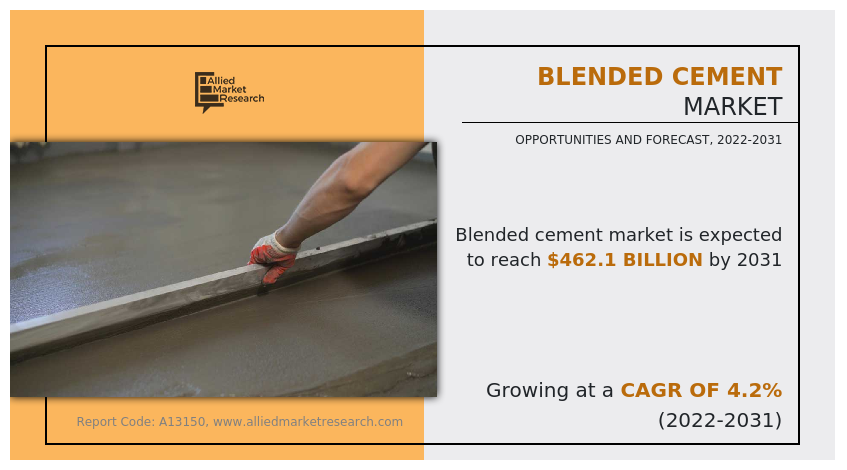
Market Dynamics
Rise in population, surge in urbanization, and increase in the disposable income of people drive the growth of the blended cement market. By 2040, the global population is estimated to grow by approximately two billion with the urban population growing by 46%, triggering massive demand for infrastructure support such as roads, subways, tunnels, common areas, and commercial infrastructures. In addition, the Government of India is strongly focused on infrastructure development to boost economic growth and is aiming for 100 smart cities.
The Government also intends to expand the capacity of railways and the facilities for handling and storage to ease the transportation of cement and reduce transportation costs. These measures would lead to increased construction activity, thereby boosting the blended cement market growth. Rising demand for construction and infrastructure development is driving the market significantly. The blended cement market is growing with increasing demand for residential, commercial, industrial, and public infrastructure. In emerging markets, infrastructure development will create a need for blended cement, which will have a positive impact on the market. Moreover, expenditure on infrastructure development such as improvement of roads, bridges, and others has been witnessed to increase.
For instance, with the new National Infrastructure Pipeline project of India, the country aims to develop social and economic infrastructure such as roads and highways, railway networks, ports, shipping, and inland waterways infrastructure. Expenditure for this is expected to be around $759.76 billion over a period of five years between 2020 and 2025. This is expected to drive demand for the blended cement market. Similarly, $1 trillion bi-partisan infrastructure law of the U.S. is also expected to positively influence the market.
Similarly, a wide range of advantages offered by blended cement fuels market growth. Blended cement improved workability, durability, and strength and it is an eco-friendly cement suitable for both hot and cold weather. It also increases efficiency, reduce energy consumption, and reduces pollutants and CO2 emissions. In addition, the availability of alternate materials and heavy price fluctuations of raw materials such as limestone restrained the market growth. Moreover, expanding construction projects and infrastructure developments accelerate opportunities for the blended cement market. For instance, the Belt Road Initiative by China is one of the most striving infrastructural projects in current times and is expected to consume a huge amount of blended cement for its construction. In addition, there has been a rise in demand for superior quality cement as it offers greater durability and strength, thereby augmenting the blended cement market growth.
The demand for blended cement decreased in 2020, owing to low demand from different industries due to lockdowns imposed by the government of many countries. The COVID-19 pandemic has shut down the production of blended cement, mainly owing to prolonged lockdowns in major global countries. This has hampered the growth of the blended cement market significantly during the pandemic. The major demand for blended cement was previously noticed from giant manufacturing countries including the U.S., Germany, India, and China, which was badly affected by the spread of coronavirus, thereby halting demand for blended cement. Blended cement manufacturers must focus on protecting their workforce, operations, and supply chains to respond to immediate crises and find new ways of working after COVID-19 infection cases start to decrease.
Segmental Overview
The blended cement market is segmented into Type, Application, End user industry, and Region. By type, it is divided into Portland Pozzolana Cement (PPC), Portland slag cement (PSC), composite cement, and others. By application, the blended cement market is classified into precast construction and cast-in-place construction. By end-user industry, it is divided into building construction and infrastructure. By region, it is analyzed across North America, Europe, Asia-Pacific, and LAMEA.
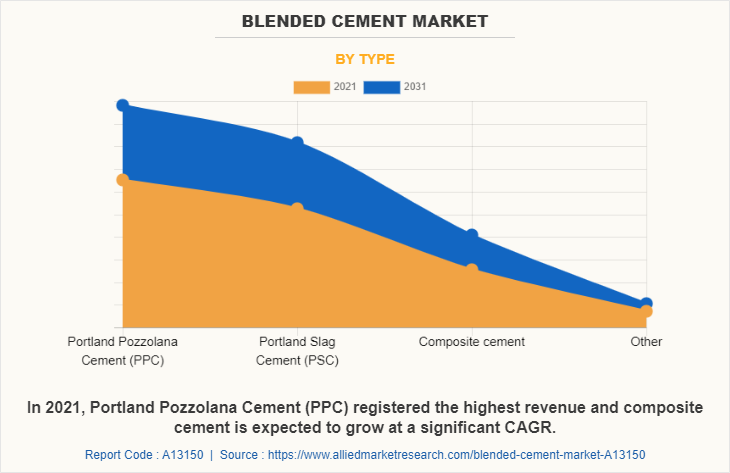
By Type:
The blended cement market is divided into Portland Pozzolana Cement (PPC), Portland slag cement (PSC), composite cement, and others. In 2021, Portland Pozzolana Cement (PPC) registered the highest revenue and composite cement is expected to grow at a significant CAGR. Portland pozzolanic cement (PPC) is a synthetic cement made by reacting ordinary Portland cement (OPC) with pozzolanic raw materials. It is originally discovered in Italy and named by the Romans, this cement is an affordable choice and highly resistant to alkaline reactions and marine corrosion.
It is used for surrounding structures. PPC is an eco-friendly cement made from natural recycled waste and has a low carbon monoxide emission rate. It is used in the construction of structures near water reservoirs such as seas, rivers and dams owing to its waterproof properties. It is also used for masonry mortars and plastering works, owing to its finishing is very smooth, which makes it ideal to be used in plastering. In addition, it is fine in nature, fill the gaps between structures and reduces shrinkage, which results in more durable and high tensile structure is expected to fuel the demand of blended cement market.
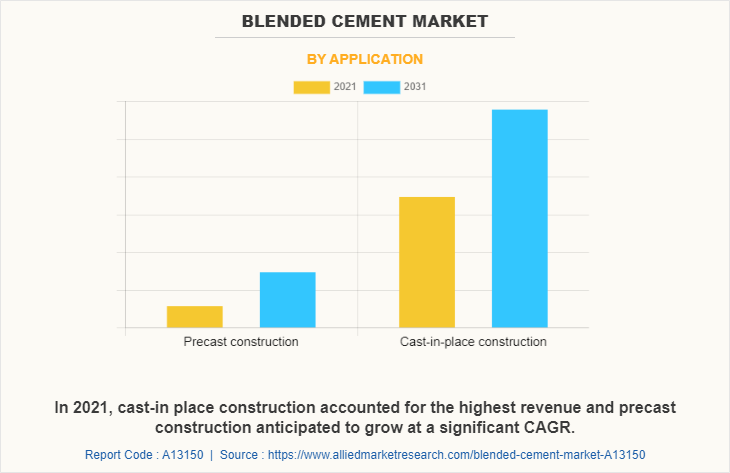
By Application:
The blended cement market is classified into precast construction and cast-in-place construction. In 2021, cast-in place construction accounted for the highest revenue and precast construction anticipated to grow at a significant CAGR. Cast-in-place construction is the simplest form of mixture of paste and aggregate or stone. A paste consisting of Portland or blended cement and water coats the surface of fine aggregate (small) and coarse aggregate (large). A chemical reaction called hydration causes the paste to harden and gain strength, forming a stone-like mass known as concrete.
Blended cement is used for the cast-in place construction owing to its various features such as superior performance advantages, improved workability, durability, strength and better construction. It is also weather resistant, enhances efficiency and reduces the amount of energy used, and generates lesser pollutants and carbon emissions. Such advantages provide lucrative opportunities for the growth of the blended cement market.
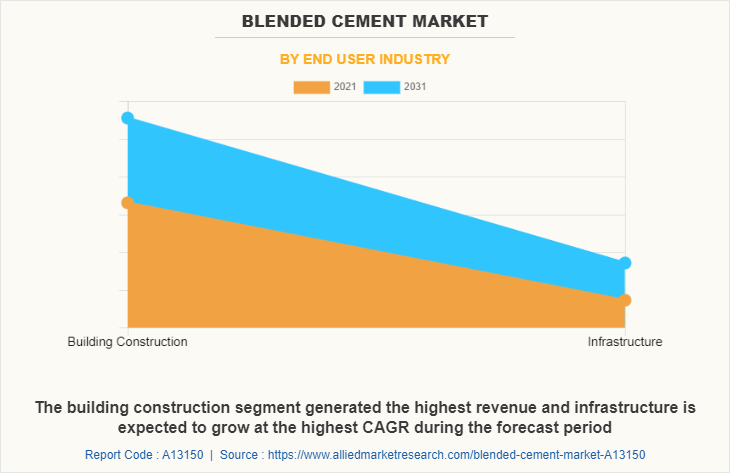
By End- User Industry:
The blended cement market is divided into building construction and infrastructure. The building construction segment generated the highest revenue and infrastructure is expected to grow at the highest CAGR during the forecast period owing to growth in population and rapid urbanization, particularly in emerging economies has have helped the construction industry to witness growth in recent years. The new construction projects are expected to increase the demand for blended cement, owing to their strength, environment friendly, and cost-effectiveness. Furthermore, an increase in government investments in housing projects is projected to lead to increase in demand for blended cement during the forecast period. For instance, in February 2021, the government of India invested more than $3 billion. This investment is done to complete stalled housing projects in the country. Thus, this in turn is expected to drive the growth of the market.
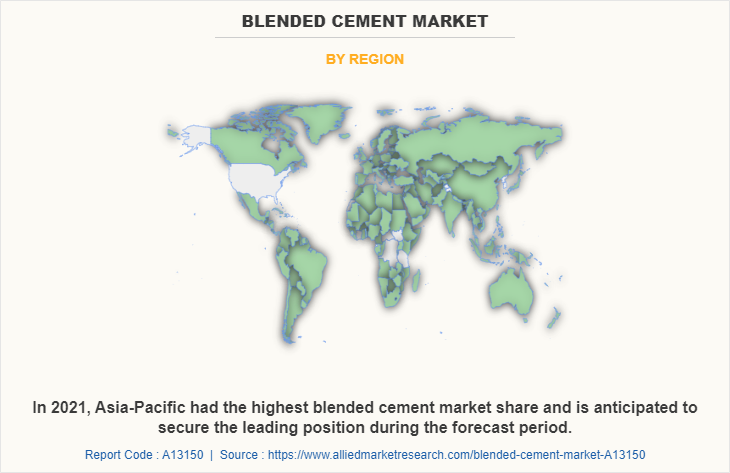
By Region:
The blended cement market is analyzed across North America, Europe, Asia-Pacific, and LAMEA. In 2021, Asia-Pacific had the highest blended cement market share and is anticipated to secure the leading position during the forecast period. Asia-Pacific includes majority of developing countries, such as India, Vietnam, and Indonesia, which exhibit lucrative opportunities for the blended cement market. Moreover, growth in infrastructure development in emerging countries, such as India and China, is anticipated to cater to the growth of the blended cement market.
For instance, China invested around $20 billion on a mega petrochemical project complex in Yantai, Shandong, China. In addition, China is the largest cement producer in the world and holds a 57% share of global cement production. Moreover, India is the second largest cement producer in the world, after China has evolved to become one of the best in terms of energy efficiency, quality control, and environmental improvement. Indian cement industry has also been a strong contributor to employment, fiscal revenue, and community development while achieving manufacturing and technological advancement. Thus, improvement in the overall growth of construction activities in Asia-Pacific is expected to create opportunities for growth of the blended cement market. Furthermore, the increasing population and rising household income in the region are expected to further drive the growth of the construction of commercial buildings; thereby providing lucrative growth opportunities for the growth of the blended cement market.
COMPETITION ANALYSIS
Competitive analysis and profiles of the major players in the blended cement market include Ambuja Cements Ltd, Anhui Conch Cement Company Limited, Buzzi Unicem SpA, China National Building Material Company Limited, CRH plc, CEMEX S.A.B DE C.V., Dalmia Bharat Limited, Holcim, HeidelbergCement AG, UltraTech Cement Limited are provided in this report. Major players have adopted product launch and acquisition as key developmental strategies to improve the product portfolio of the blended cement market.
Some examples of product launches in the market
In December 2021, LafargeHolcim which is a subsidiary of Holcim Group in the U.S. has launched a new product, TerCem. This product is a blended cement and offers a 65% reduction in CO2 emission as compared to ordinary Portland cement.
In September 2021, Finnsementti, a CRH Company based in Finland has launched a new product named, Kolmossementti. This innovative product reduces carbon emission by 40% and this is achieved by reducing the clinker factor of the cement by using Ground Granulated Blast Furnace Slag (GGBFS).
Acquisitions in the market
In December 2022, Dalmia Cement (Bharat) Limited which is a wholly owned subsidiary of Dalmia Bharat acquired cement, clinker, and power plants from Jaiprakash Associates and its associate having total cement capacity of 9.4 million tonnes (MnT). The acquisition will strengthen the presence of Dalmia in the central region of India.
In January 2022, HeidelbergCement announced that its North American subsidiary Lehigh Hanson has acquired Corliss Resources, Inc., which is one of the largest manufacturer of aggregates and ready-mixed concrete. This acquisition will strengthen the presence of HeidelbergCement AG in the U.S. market.
Investments in the market
In April 2022, CEMEX S.A.B DE C.V. invested in Carbon Upcycling Technologies, a solution that enables the reduction of carbon emissions in cement and concrete production by up to 30% through clinker, slag and fly ashes substitutes.
Business Expansion in the market
In May 2022, Anhui Conch Cement Company Limited expanded its geographical presence by has commissioned a new cement plant in Kashkadarya region of Uzbekistan. This cement plant has a capacity of about 1.2 mtpa.
KEY BENEFITS FOR STAKEHOLDERS
- The report provides an extensive analysis of the current and emerging global blended cement market trends and dynamics.
- In-depth market global blended cement market analysis is conducted by constructing market estimations for key market segments between 2022 and 2031.
- Extensive analysis of blended cement market is conducted by following key product positioning and monitoring of top competitors within the market framework.
- A comprehensive analysis of all the regions is provided to determine the prevailing opportunities.
- Blended cement market forecast analysis from 2022 to 2031 is included in the report.
- The key players within blended cement market overview are profiled in this report and their strategies are analysed thoroughly, which help understand the competitive outlook of blended cement industry.
Blended Cement Market Report Highlights
| Aspects | Details |
| Market Size By 2031 | USD 462.1 billion |
| Growth Rate | CAGR of 4.2% |
| Forecast period | 2021 - 2031 |
| Report Pages | 195 |
| By Application |
|
| By End user industry |
|
| By Type |
|
| By Region |
|
Analyst Review
The blended cement market has observed huge demand in North America, Asia-Pacific, and Europe. Asia-Pacific registered the highest share of the global blended cement market share in 2021, owing to strong economic growth, rapid urbanization, and presence of large population base significantly contributing toward the growth of the blended cement market in Asia-Pacific. Portland Pozzolana cement registered the highest revenue and composite cement is expected to grow at a significant CAGR. PPC is an eco-friendly cement made from natural recycled waste and has a low carbon monoxide emission rate. It is used in the construction of structures near water reservoirs such as seas, rivers, and dams owing to its waterproof properties. It is also used for masonry mortars and plastering works, owing to its finishing is very smooth, which makes it ideal to be used in plastering.
Various market players have adopted strategies such as product launch, business expansion, Investment, and acquisition to expand their business and strengthen their market position. For instance, In December 2022, Dalmia Cement (Bharat) Limited which is a wholly-owned subsidiary of Dalmia Bharat acquired cement, clinker, and power plants from Jaiprakash Associates and its associate having total cement capacity of 9.4 million tonnes (MnT). The acquisition will strengthen the presence of Dalmia in the central region of India. As a result, such strategic moves are expected to provide lucrative growth opportunities in the global blended cement market.
The global blended cement market was valued at $301,162.7 million in 2021, and is projected to reach $462,110.7 million by 2031, registering a CAGR of 4.2% from 2022 to 2031.
The base year considered in the global Blended Cement market report is 2021.
Cast-in-place construction is the leading application of the Blended Cement Market.
Asia-Pacific is the largest regional market for Blended Cement.
Rising demand for construction and infrastructure development are the upcoming trends of Blended Cement Market in the world.
Ambuja Cements Ltd, Anhui Conch Cement Company Limited, Buzzi Unicem SpA, China National Building Material Company Limited, CRH plc, CEMEX S.A.B DE C.V., Dalmia Bharat Limited, Holcim, HeidelbergCement AG, UltraTech Cement Limited are the top companies to hold the market share in Blended Cement.
The top 10 market players are selected based on two key attributes- competitive strength and market positioning.
The report contains an exclusive company profile section, where leading 10 companies in the market are profiled. These profiles typically cover company overview, geographical presence, market dominance (in terms of revenue and volume sales), various strategies and recent developments.
Loading Table Of Content...
Loading Research Methodology...


